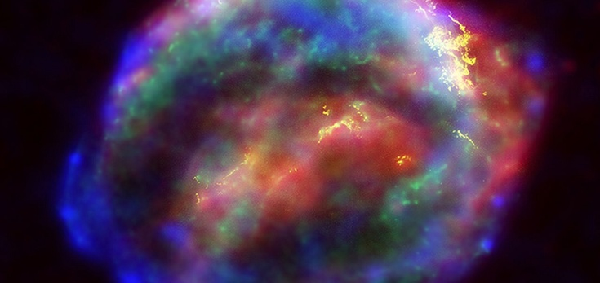Radioactive Cobalt Detected on Supernova SN2014J
| Paula Marie Navarra | | Aug 31, 2014 12:57 AM EDT |
(Photo : NASA) Supernova
Radioactive cobalt detected during a supernova explosion by international researchers that questions the prevailing theory about exploding supernovas.
The Integral Gamma-Ray Orbital Telescope detected radioactive cobalt isotopes that have a half-life of 77 days and that can't exist in normal conditions.
Like Us on Facebook
Russian astrophysicists said there were enormous quantities of cobalt isotopes released during a thermonuclear supernova exposition in Supernova SN2014J, which is 11 million light years from Earth,.
Astrophysicists said they've never seen such a close-range spectrum before such a short distance from Earth.
They argue these kinds of supernovae only occur once every few centuries. The last recorded supernova explosion was observed in 1606 in our Milky Way galaxy.
Earlier theories said that during a supernova, the star barely radiates gamma energy during the first few days.
When the outer layer of the star becomes powerful enough, the supernova starts producing more gamma radiation.
Radioactive nickel, which has a life of 10 days, synthesizes during the explosion and transforms into radioactive cobalt.
The radioactive cobalt releases a surplus of energy as it continuously forms while other isotopes produce different energies.
Using the integral telescope, an operational space telescope used for observing gamma rays, the Russians found out a radioactive explosion emits 60 percent more gamma radiation than the Sun.
Astrophysicists believe the result of the supernova explosion can confirm that matter from Earth underwent thermonuclear explosions.
The information came from the Moscow Institute of Physics and Technology.
©2015 Chinatopix All rights reserved. Do not reproduce without permission
EDITOR'S PICKS
-

Did the Trump administration just announce plans for a trade war with ‘hostile’ China and Russia?
-

US Senate passes Taiwan travel bill slammed by China
-

As Yan Sihong’s family grieves, here are other Chinese students who went missing abroad. Some have never been found
-

Beijing blasts Western critics who ‘smear China’ with the term sharp power
-

China Envoy Seeks to Defuse Tensions With U.S. as a Trade War Brews
-

Singapore's Deputy PM Provides Bitcoin Vote of Confidence Amid China's Blanket Bans
-

China warns investors over risks in overseas virtual currency trading
-

Chinese government most trustworthy: survey
-

Kashima Antlers On Course For Back-To-Back Titles
MOST POPULAR
LATEST NEWS
Zhou Yongkang: China's Former Security Chief Sentenced to Life in Prison

China's former Chief of the Ministry of Public Security, Zhou Yongkang, has been given a life sentence after he was found guilty of abusing his office, bribery and deliberately ... Full Article
TRENDING STORY

China Pork Prices Expected to Stabilize As The Supplies Recover

Elephone P9000 Smartphone is now on Sale on Amazon India

There's a Big Chance Cliffhangers Won't Still Be Resolved When Grey's Anatomy Season 13 Returns

Supreme Court Ruled on Samsung vs Apple Dispute for Patent Infringement

Microsoft Surface Pro 5 Rumors and Release Date: What is the Latest?










